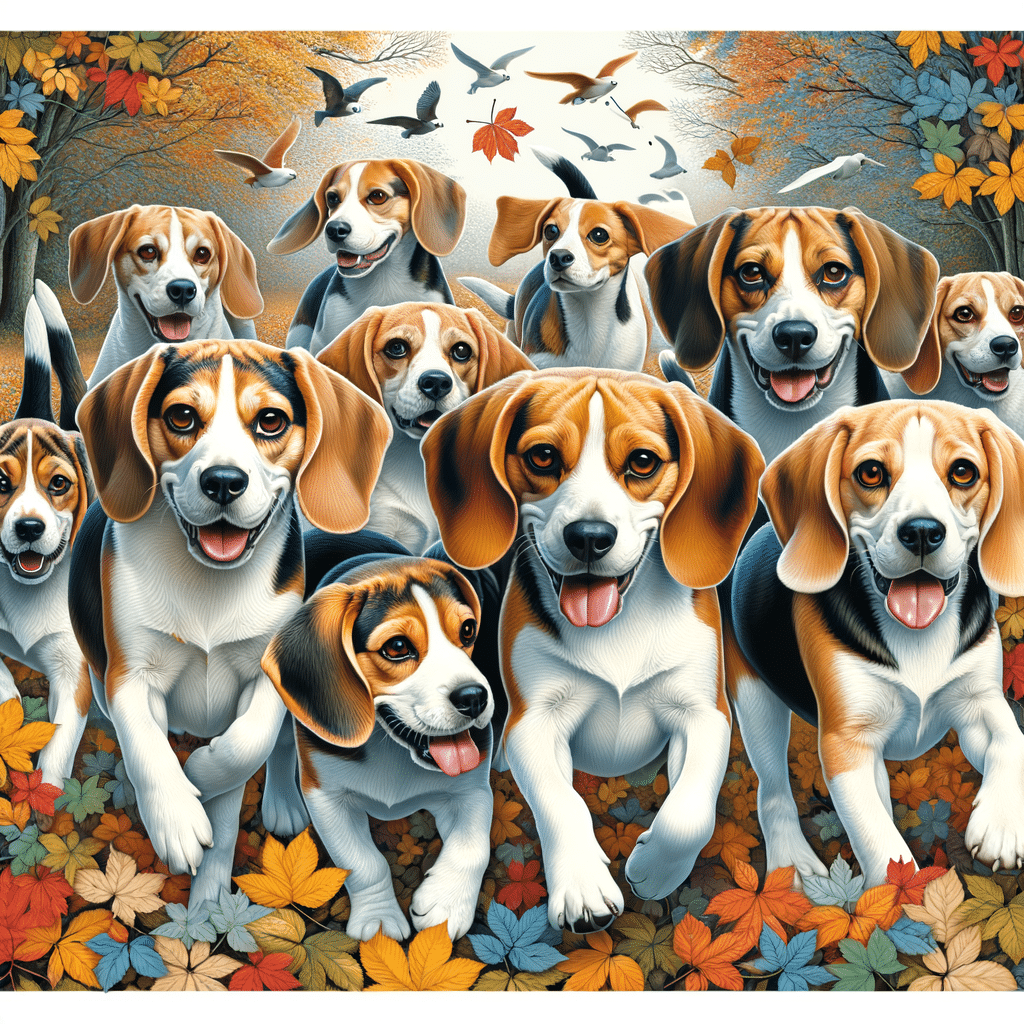Breed characteristics are often a pivotal factor when considering the addition of a dog to the family. So, choosing a beagle vs. a German shepherd can be a tough question. They represent two vastly different options, with unique traits suited to different lifestyles and preferences.
In This Article
Owners love beagles for their compact size and friendly demeanor, making them excellent companions, especially for families with children. In contrast, owners appreciate German shepherds for their larger size, intelligence, and versatility, serving roles from family pets to various types of working dogs.
Both breeds have a storied history that evolved into their modern-day temperaments and physical characteristics. While beagles have been favored for their keen sense of smell and tracking abilities, German shepherds have an excellent work ethic and capability in protection and service positions.
Prospective owners must consider not only the physical and health aspects of each breed but also their behavioral tendencies and the care required to ensure a healthy and happy life for their four-legged companions.
Highlights
- Beagles and German shepherds cater to different owner lifestyles with their unique characteristics.
- Historical roles of each breed have shaped their present-day temperaments and abilities.
- Considering physical traits, temperament, and care needs is crucial in choosing the right breed.
Breed Origins and History
Exploring the origins and history of two diverse breeds, the beagle and the German shepherd, uncovers a rich tapestry of purpose-driven development. Each breed’s inception is marked by distinct societal needs, which have shaped its characteristics and roles throughout history.
Beagle Beginnings
The beagle’s lineage can be traced back to Roman times, but its development as a breed began in earnest in England before the Roman Empire. Historically, beagles were bred for hunting small game due to their keen sense of smell and stout build, making them excellent for tracking hares and other small animals.
They were lauded for their stamina and vocal nature during hunts, often working in packs. This strong history has entrenched the beagle as a favored hunting companion and a popular family pet, beloved for its affable nature.
German shepherd Development
In contrast, the German shepherd breed was meticulously engineered in Germany at the end of the 19th century. Originating from various herding dogs, they were refined by Captain Max von Stephanitz, who aimed to produce a dog that embodied both intelligence and working ability.
Germany’s rigorous programs have always focused on improving the breed’s capabilities, resulting in a dog well-suited for work in military and police roles. Having contributed to both World Wars, they gained international recognition for their versatility and trainability, which remains a cornerstone of the German shepherd’s identity today.
Physical Characteristics and Health
Distinctive physical attributes and prevalent health concerns are key considerations when comparing beagles and German shepherds. Each breed has specific traits and genetic predispositions that affect its well-being.
Beagle Attributes
Size and Weight
- Size: Small to medium.
- Weight: Approximately 20 to 30 pounds.
Color and Coat
- Colors: Tricolor, red and white, orange and white, lemon, blue tick, and more.
- Coat: Short-haired, hard coat for easy grooming.
German Shepherd Traits
Size and Weight
- Size: Large.
- Weight: Ranges between 50 to 90 pounds.
Color and Coat
- Colors: Typically tan with black saddle, sable, blue, liver, and all black.
- Coat: A dense double coat requires regular grooming and experiences seasonal shedding.
Health Concerns in Beagles and German Shepherds
Beagle Health
- Life expectancy: Generally between 12 to 15 years
- Common conditions:
- Obesity
- Epilepsy
- Hypothyroidism
- Chronic ear infections
German Shepherd Health
- Life expectancy: Usually about 9 to 13 years
- Common conditions:
- Hip dysplasia and Elbow dysplasia
- Degenerative myelopathy
- Bloat (Gastric Dilatation-Volvulus)
- Panosteitis
Both breeds also face a risk of cancer and require attentive care from their owners to manage potential health issues. Regular check-ups with a veterinarian and proactive measures are essential for maintaining health and vitality in beagles and German shepherds.
Temperament and Behavior
Temperament and behavior play significant roles in determining the suitability of a dog breed for a household or individual lifestyle. Beagles are known for their playful nature and friendliness, especially towards children, while German shepherds have a more protective and intelligent demeanor, with high energy and strong guarding instincts.
Beagle Personality Traits
Beagles are affectionate and friendly dogs that excel in a family environment. They are particularly kid friendly and enjoy active play sessions. Recognized for their energetic and curious personalities, beagles love to explore and hunt with their keen sense of smell. They can be stubborn at times but respond well to creative training techniques.
- Energy level: High; requires regular exercise.
- Social: Very sociable; usually get along well with other pets.
- Barking: May howl or bark when excited or on the scent trail.
- Allergies: A short coat and minimal grooming are required; it is suitable for those with allergies.
German Shepherd Behavior
The German shepherd is valued for intelligence, strength, and guarding abilities. These traits make German shepherds excellent working dogs in various fields, including herding and protection. They are affectionate with their families and can be kid-friendly when raised and socialized properly. Often perceived as aloof with strangers, they are innately protective and may require formal training to manage their guarding instincts.
- Exercise needs: High; they require ample daily exercise to maintain their physical and mental health.
- Independent vs. social: Tend to be independent but loyal, needs social interaction.
- Barking and guarding: Potentially vocal, strong instinct to guard and protect.
- LifestylefFit: Best suited for an active lifestyle where they can use their energy and intelligence.
Care and Lifestyle Needs
When considering the care and lifestyle needs of beagles and German shepherds, prospective pet owners must account for differences in living environments, training and exercise requirements, and feeding and health management strategies. These factors are crucial in ensuring that each breed leads a happy and healthy life.
Living Environments
Due to their smaller size, beagles typically adapt well to various living situations, including apartment living. They require space to roam and explore but can manage indoors if they have daily walks.
In contrast, the German shepherd dog thrives in more spacious environments where it has room to run and play. Its larger size and higher activity levels make it less suitable for small apartments unless it is taken out frequently for extensive exercise.
Both breeds enjoy being part of families and do well in a family setting with a secure yard.
Training and Exercise
Training for both breeds should start early. Popular dog breeds like German shepherds show a solid aptitude for obedience and protective roles, often serving as police and watchdogs. They require consistent, firm training sessions combined with plenty of daily exercise to maintain their mental and physical health.
While intelligent, beagles can be more independent and may need more patience during training. They enjoy games and running, which can be incorporated into their exercise routine to prevent obesity and keep them engaged.
Feeding and Health Management
German Shepherds
- Prone to obesity: Careful monitoring of diet is required.
- Exercise needs: High; includes daily walks, runs, and mental stimulation.
Beagles
- Moderate exercise: Daily walks with occasional free play are typically sufficient for dog health.
- Health considerations: Watch for signs of obesity due to lower activity requirements.
Both breeds require a balanced diet tailored to their age, size, and activity level. Considering their size, German shepherds may need more food, but care must be taken to prevent overfeeding. Beagles are known to have hearty appetites and can overeat if dog food is not appropriately managed.
Alongside a healthy diet, dog owners need to deploy regular grooming for both breeds. German shepherds, like all working dogs, require frequent brushing due to the thick fur. Beagles with shorter coats have lower grooming needs with shorter coats.
Frequently Asked Questions
This section addresses some of the most common inquiries regarding the differences between beagles and German shepherds, focusing on temperament, size, behavior, suitability for families, training, and exercise requirements.
What are the primary differences in temperament between beagles and German shepherds?
Beagles are known for their friendly and curious nature. They are often sociable and good with children. German shepherds, on the other hand, have a more protective and loyal temperament, making them excellent guard dogs.
How does the size of a beagle compare to that of a German shepherd?
A beagle is generally smaller than a German shepherd. Beagles typically stand about 13 to 15 inches tall and weigh between 20 and 30 pounds, while German shepherds can stand about 22 to 26 inches tall at the shoulder and weigh between 50 and 90 pounds.
What are breed-specific behaviors comparing beagles to German shepherds in household environments?
Beagles have a strong sense of smell and a tendency to follow scents, which can sometimes lead to distraction. They are also known for their vocalization. German shepherds are likely to be vigilant and show a strong territorial instinct, often excelling in roles requiring alertness and responsiveness.
When considering a pet for family settings, which breed is known to be more friendly, beagles or German shepherds?
Beagles tend to be more universally friendly and are often more easily adaptable to various family settings given their generally genial temperament. German shepherds are friendly within their family unit but may be reserved with strangers, reflecting their protective nature.
How do beagles and German shepherds differ in training and obedience?
German shepherds are widely recognized for their trainability and intelligence. They often excel in obedience and tasks that require mental engagement. In contrast, beagles may present more of a challenge in training due to their independent and sometimes stubborn character.
Are there significant differences in exercise requirements between a beagle and a German shepherd?
German shepherds require substantial daily exercise due to their high energy levels and working breed heritage. They thrive with tasks and challenges. Beagles also need regular exercise to manage their weight and energy but not as intensely as German shepherds.






